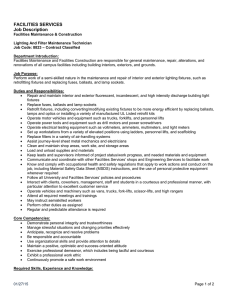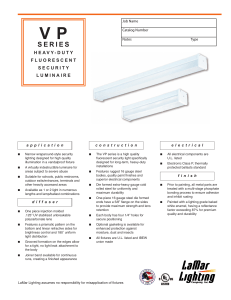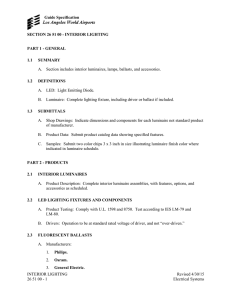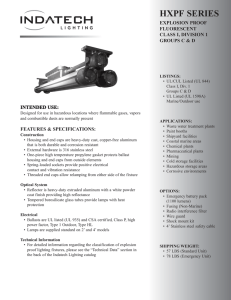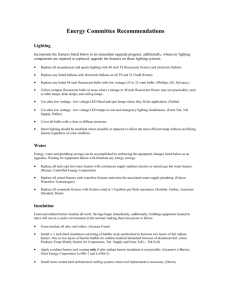ICLS performance specification
advertisement
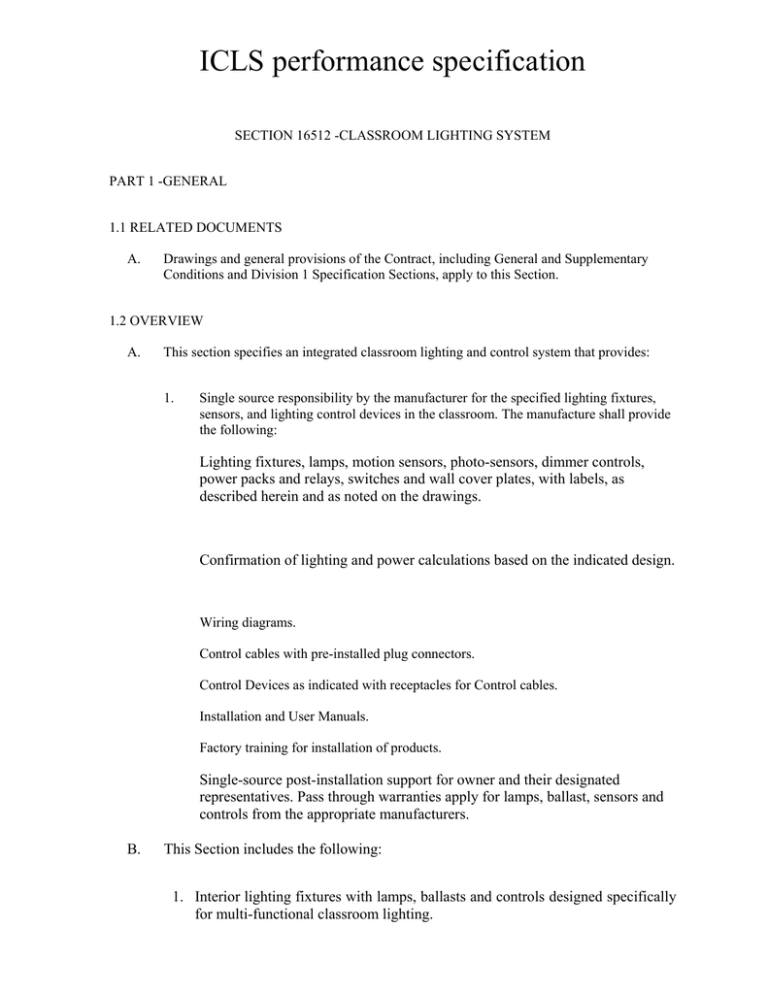
ICLS performance specification SECTION 16512 -CLASSROOM LIGHTING SYSTEM PART 1 -GENERAL 1.1 RELATED DOCUMENTS A. Drawings and general provisions of the Contract, including General and Supplementary Conditions and Division 1 Specification Sections, apply to this Section. 1.2 OVERVIEW A. This section specifies an integrated classroom lighting and control system that provides: 1. Single source responsibility by the manufacturer for the specified lighting fixtures, sensors, and lighting control devices in the classroom. The manufacture shall provide the following: Lighting fixtures, lamps, motion sensors, photo-sensors, dimmer controls, power packs and relays, switches and wall cover plates, with labels, as described herein and as noted on the drawings. Confirmation of lighting and power calculations based on the indicated design. Wiring diagrams. Control cables with pre-installed plug connectors. Control Devices as indicated with receptacles for Control cables. Installation and User Manuals. Factory training for installation of products. Single-source post-installation support for owner and their designated representatives. Pass through warranties apply for lamps, ballast, sensors and controls from the appropriate manufacturers. B. This Section includes the following: 1. Interior lighting fixtures with lamps, ballasts and controls designed specifically for multi-functional classroom lighting. 2. Accessories: As noted on the plans, provide Teacher Control Center, Single Pole Switches, Low Voltage Switches, dimmer controls (optional), occupancy sensors, and/or light level photo-sensors (optional). C. Related Sections include the following: 1. Division 16 Section "Raceways and Boxes". 2. Division 16 Section "Conductors and Cables". 1.3 DEFINITIONS A. BF: Ballast Factor. Ratio of light output of a given lamp(s) operated by the subject ballast to the light output of the same lamp(s) when operated on an ANSI reference circuit. B. CRI: Color Rendering Index. C. CU: Coefficient of Utilization. D. LER: Luminaire Efficiency rating, which is calculated according to NEMA LE 5. This value can be estimated from photometric data using the following formula: 1. E. LER is equal to the product of total rated lamp lumens times BF times luminaire efficiency, divided by input watts. RCR: Room Cavity Ratio. 1.4 PERFORMANCE REQUIREMENTS A. The Classroom Lighting System shall consist of: pendant luminaires with specified ballast factor, lamps with specified lumen output and CRI, Teacher Control Center, Dimmer Control (if specified herein), faceplates with specified la bels, motion control sensors, photo sensors (if specified herein), Relay Control Interface with Modular receptacles, Plenumrated Low-Voltage Control cables with modular connectors, and control components. B. The pendant luminaires shall contain two rows of 48-inch fluorescent lamps whose primary luminous distribution is upward and one center row of 48-inch fluorescent lamps whose primary luminous distribution is downward. These rows shall be dual switched per information to follow. D. The control system shall consist of: 1. A Teacher Control Center (TCC) located near the teacher’s primary teaching position. Teacher will select uplight on or downlight on, but uplight and downlight cannot be on at the same time. The cover plate for the Teacher Control Switch will be labeled “GENERAL” and “A/V MODE”. Wiring from the TCC shall be through factory wired receptacle and factory supplied lowvoltage cable with pre-installed connectors as described. 2. “Quiet Time Switch”. The instructor can use a toggle switch on the TCC to send a signal to the motion sensor. When the switched is toggled, the lighting in the classroom will stay on even in the absence of motion, for one hour. After one hour, the motion sensor will automatically restore to its previous state. The instructor can toggle the switch at any time to re-set “Quiet-Time” to a full 60 minute on period. While in “Quiet Time” mode the instructor will have full control of the classroom lighting. The label on the TCC will read “QUIET TIME 1 HOUR ON”. 3. Motion Sensor shall be ceiling-mounted and connect to the lighting system through low-voltage wiring using factory-installed receptacles and factory supplied cable with pre-installed connectors as described. The sensor shall turn lights on when both PIR and ultrasonic sensors detect occupancy. Once on, detection by either sensor will keep the lights on. A field adjustable time-delay shall be factory preset to recommended NEMA standards. Sensitivity settings shall adjust automatically through integrated sensor technology. 4. (Optional) The downlight of each luminaire shall be dimmed to 5% of the initial light level. The TCC contains the dimmer control unit, which is labeled “A/V MODE DIMMING.” 5. (Optional) Daylight Control sensor shall be ceiling-mounted facing the primary window wall and located approximately one-half way between the first row of luminaries and the wall. It shall provide for user-adjustable light level setting between 10 and 1000 footcandles. It shall provide for an adjustable dead band setting to prevent lighting system cycling. The Daylight Control sensor shall be connected to a set of relays by plug together low voltage cables. The relays will be used to turn off one-half of the uplights in each row when the sensor indicates that sufficient daylight is present. Sensor will be factory calibrated to reduce the field commissioning time to calibrate the units. E. Performance of uplight portion (General Mode) of the luminaries: 1. General Mode shall provide a maintained average horizontal illuminance of 35 to 50 footcandles with a minimum of 25 footcandles at any point more than 3 feet from any wall. Lighting power density shall be equal to or less than (1.0) watt per square foot. 2. Performance results will be calculated as follows: Horizontal light reading averages shall be taken from an area 3-feet in from each wall with readings every foot. Standard reflectances used should be 80/50/20. F. Performance of downlight portion (A/V Mode) of the luminaries: 1. Audiovisual (AV) Mode shall provide an average horizontal illuminance of 10 to 20 footcandles for any point in the room greater than 3 feet from the side walls, 10 feet from the front wall and 6 feet from the back wall, while limiting vertical illumination on the projection screen to no more than 7 footcandles at any point on the screen. Lighting power density shall be equal to or less than (0.5) watts per square foot. 2. Performance results will be calculated as follows: Horizontal light reading averages shall be taken from an area 3 feet from the side walls, 10 feet from the front wall and 6 feet from the back wall with readings every foot. Standard reflectances used should be 80/50/20. F. The Classroom Lighting System shall be shipped from the luminaire manufacturer complete with luminare, ballasts, lamps, fixture supports, applicable control components, control cables, and device coverplates. The installer shall supply standard electrical components such as, but not limited to, electrical boxes, conduit, building wire, etc. 1.5 SUBMITTALS A. Product Data: For specified lighting fixture. Include data on features, accessories, finishes, and the following: 1. Physical description of luminaire, including dimensions and verification of indicated parameters. 2. Certified Photometric Test Report prepared by an independent testing laboratory. 3. Fluorescent ballasts. 4. Lamps. 5. Control components: Switches, dimmers, occupancy sensors, light level sensors, relays. B. Shop Drawings: Show details of luminaires. Indicate dimensions, weights, and method of field assembly, components, features, accessories, and location and size of each field connection. C. Wiring Diagrams: Power, and control wiring. 1. D. Operation and Maintenance Data: For lighting equipment and fixtures to include: inoperation, and maintenance manuals. Warranties: Special warranties specified in this Section. 1.6 QUALITY ASSURANCE A. Manufacturer Qualifications: The manufacturer shall have not less that ten years experience of manufacturing pendent fluorescent luminaires. B. Electrical Components, Devices, and Accessories: Listed and labeled as defined in NFPA 70, Article 100, by a testing agency acceptable to authorities having jurisdiction, and marked for intended use. C. Comply with NFPA 70. D. Mockups: If required for this project, provide luminaires and accessories for room or module mockups. Install luminaires for mockups with power and control connections. 1. Obtain Architect's approval of luminaires for mockups before starting installations. 2. Maintain mockups during construction in an undisturbed condition as a standard for judging the completed Work. 3. Approved luminaires in mockups may become part of the completed Work if undisturbed at time of Substantial Completion. E. Source Limitations: Obtain Classroom Lighting System through one source from a single manufacturer. 1.7 DELIVERY, STORAGE, AND HANDLING 1.8 PROJECT CONDITIONS: Existing Facilities A. Interruption of Existing Classrooms: Do not interrupt electrical service to facilities occupied by Owner or others unless permitted under the following conditions and then only after arranging to provide temporary electrical service according to requirements indicated: 1. Notify [Architect] [Construction Manager] [Owner] no fewer than four days in advance of proposed interruption of electrical service. 2. Do not proceed with interruption of electrical service without [Architect's] [Cons truction Manager's ] [Owner's] written permission. 1.9 COORDINATION A. Coordinate layout and installation of lighting fixtures and suspension system with other construction that penetrates ceilings or is supported by them, including HVAC equipment, fire-suppression system, and partition assemblies. 1.10 WARRANTY A. Special Warranty for Fluorescent Ballasts: Manufacturer's standard form in which ballast manufacturer agrees to repair or replace balla sts that fail in materials or workmanship within specified warranty period. 1. B. Warranty Period for Electronic Ballasts: Five years from date of Substantial Completion. Manufacturer's Special Warranty for T8 Fluorescent Lamps: Manufacturer's standard form, made out to Owner and signed by lamp manufacturer agreeing to replace lamps that fail in materials or workmanship, f.o.b. the nearest shipping point to Project site, within specified warranty period indicated below. 1. Warranty Period: Two years from date of Substantial Completion. 1.11 EXTRA MATERIALS A. Furnish extra materials described below that match products installed and that are packaged with protective covering for storage and identified with labels describing contents. 1. Lamps: 1 for every 200 of each type and rating installed. Furnish at least one of each type. 2. Parabolic Diffusers: 1 for every 500 of each type and rating installed. Furnish at least one of each type. 3. Ballasts: 1 for every 500 of each type and rating installed. Furnish at least one of each type. 4. Occupancy Sensors: 1 for every 200 of each type and rating installed. Furnish at least one of each type. 5. Light Level Sensors: 1 for every 200 of each type and rating installed. Furnish at least one of each type. 6. Dimmer Controllers: 1 for every 200 of each type and rating installed. Furnish at least one of each type. 7. Power Pack Relays: 1 for every 200 of each type and rating installed. Furnish at least one of each type. PART 2 -PRODUCTS 2.1 MANUFACTURERS A. Available Manufacturers: Subject to compliance with requirements, manufacturers offering products that may be incorporated into the Work include, but are not limited to, the following: 1. B. Classroom Lighting System: Finelite or approved equal. Submit documents for approval 10 days prior to bid. Available Products: Subject to compliance with requirements, products that may be incorporated into the Work include, but are not limited to, products specified. 2.2 FIXTURES AND COMPONENTS, GENERAL A. Fluorescent Fixtures: Comply with UL [1570] [1598]. Where LER is specified, test according to NEMA LE 5 and NEMA LE 5A as applicable. B. Metal Parts: Free of burrs and sharp corners and edges. C. Sheet Metal Components: Steel, unle ss otherwise indicated. Form and support to prevent warping and sagging. D. Doors, Frames, and Other Internal Access: Smooth operating, free of light leakage under operating conditions, and designed to permit relamping without use of tools. Designed to prevent doors, frames, lenses, diffusers, and other components from falling accidentally during relamping and when secured in operating position. E. Reflecting surfaces shall have minimum reflectance as follows, unless otherwise indicated: 1. White Surfaces: 96 percent. 2. Specular Surfaces: 95 percent. 3. Diffusing Specular Surfaces: 85 percent. F. Plastic Diffusers, Covers, and Globes: 1. Acrylic Lighting Diffusers: 100 percent virgin acrylic plastic. High resistance to yellowing and other changes due to aging, exposure to heat, and UV radiation. a) Lens Thickness: At least 0.125 inch minimum unless different thickness is scheduled. b) UV stabilized. 2.3 LUMINAIRES A. Fixture: 1. Fixture - Optical Operation: a. Pendent mounted luminaire with an indirect/direct distribution using a semi-specular parabolic louver and a 96% or greater reflective center optical section to control the A/V mode of operation. b. In the uplight mode, the fixture shall be at least 83% efficient with 2T8 lamps operating in the uplight mode. 64% of the light distribution shall be upward and 36% down in this mode. Candela power from 55 degree to 90 degrees shall be 300 or less at all angles. c. In the downlight mode, the fixture shall be at least 64% efficient with 1 T8 lamp operating in the downlight mode. 100% of the light from this lamp will be in the downward direction. Brightness of the baffle shall be less than 360 candelas across all angles from 55 degrees to 90 degrees. d. To achieve the requirement of 1 watt per square foot or less, the fixtures must be designed to accept T8 electronic ballasts with BF ranging from .71 to 1.18. Generally, 2-row per classroom systems will use 1.18 BF ballasts for 960 square feet and 3-row per classroom systems will use .77 BF ballasts for 960 square feet. 2. Voltage: [120] [277] Volts AC. 3. Mounting: Adjustable aircraft cable system to allow up to 48-inch suspension. 4. Nominal Dimensions: 10 inches wide x 2 1/2 inches high in multiples of 48 inches long. 5. Lamps: Three per cross section. Sylvania 32 watt T8, FO32/835/XPS/ECO with a lumen rating of 3100 Lumens or equal. 6. High Ballast Factor Ballasts: 1.18 BF 3-T8 electronic ballasts. Sylvania # QT3X32 PLUS or equal. 7. Low Ballast Factor Ballasts: .77 BF 3-T8 electronic ballasts, Sylvania # QT3X32 ISL-SC or equal. 8. Dimming Ballasts: 5% - 100% 3-T8 electronic dimming ballasts with 0 to 10volt dc control. Sylvania # QTP3X32 DIM5-Q or equal. 2.4 FLUORESCENT LAMP BALLASTS A. Description: Include the following features, unless otherwise indicated: Cat# 1. Designed for type and quantity of lamps indicated at full light output. B. Electronic ballasts for linear lamps shall include the following features, unless otherwise indicated: 1. Comply with NEMA C82.11. 2. Ballast Type: Instant Start, unless otherwise indicated. 3. Dimming Ballasts: Will be rapid start or programmed start units. 4. Sound Rating: A. 5. Total harmonic distortion rating of less than 20 percent according to NEMA C82.11. 6. Transient Voltage Protection: IEEE C62.41, Category A. 7. Operating Frequency: 20 kHz or higher. 8. Lamp Current Crest Factor: Less than 1.7. 9. Parallel Lamp Circuits: Multiple lamp ballasts connected to maintain full light output on surviving lamps if one or more lamps fail. C. Ballasts for dimmer-controlled fixtures shall comply with general and fixture-related requirements above for electronic ballasts and the following features: 1. Dimming Range: 100 to 5% percent of rated lamp lumens. 2. Ballast Input Watts: Can be reduced to 25 percent of normal (93 watts reduced to 23 watts.) 3. Compatibility: Certified by manufacturer for use with specific dimming system indicated. 2.5 FLUORESCENT LAMPS A. Low-Mercury Lamps: Comply with Federal toxic characteristic leaching procedure test, and yield less than 0.2 mg of mercury per liter, when tested according to NEMA LL 1. B. T8 rapid-start low-mercury lamps, rated 32 W maximum, 3100 initial lumens (minimum), CRI of 85 (minimum), color temperature of 3500 K, and average rated life of 20,000 hours, unless otherwise indicated. 2.6 FIXTURE SUPPORT COMPONENTS A. Comply with Division 16 Section "Basic Electrical Materials and Methods" for channel- and angle -iron supports and nonmetallic channel and angle supports. B. Wires: ASTM A 641/A 641M, Class 3, soft temper, zinc-coated, [12 gage]. C. Wires For Humid Spaces: ASTM A 580/A 580M, Composition 302 or 304, annealed stainless steel, 12 gage. D. Rod Hangers: 3/16-inch- minimum diameter, cadmium-plated, threaded steel rod. E. Aircraft Cable Support: Use cable, anchorages, and intermediate supports recommended by fixture manufacturer. 2.7 FINISHES A. Fixtures: Manufacturers' standard, unless otherwise indicated. 1. Paint Finish: Applied over corrosion-resistant treatment or primer, free of defects. 2. Metallic Finish: Corrosion resistant. 2.8 LIGHTING CONTROL DEVICES A. Teacher Control Switch: SPDT switch rated for its operating voltage and current. Specification grade decorator style. B. Row Control Switches: 2PST switches rated for its operating voltage and current. Specification grade decorator style. C. Dimming Ballast Controls: Sliding-handle type with on/off control; compatible with ballast and having light output and energy input over a dimming range or 100% to 5%. Coverplates: Nylon, quantity of opens to match quantity of decorator style devices. D. D. Occupancy Sensors: Adjustable sensitivity and off delay time range of 5 to 30 minutes. a. Device Color: White b. Mounting: Ceiling-mounted. c. Occupancy detection indicator. d. Combination Sensors: Ultrasonic and infrared sensors combined. e. Ultrasonic Sensor: Crystal controlled with circuitry that causes no detection interference between adjacent sensors. f. Infrared Sensor: With daylight filter and lens to afford coverage applicable to space to be controlled. E. Light Level Sensor: Detect changes in ambient lighting level and provide supply for on/off control. 1. The detection range will be between 10 and 200 foot candles 2. The deadband will be adjustable with a 1 to 3 ratio 3. The delay will be adjustable from 3 seconds to 5 minutes 4. The sensor will operate via a 24-volt DC power supply and have a current draw of 22 milliamps. 2.9 Retain below to allow photometric tests by manufacturer's laboratory. PART 3 -Execution 3.1 INSTALLATION A. Fixtures: Set level, plumb, and square with ceilings and walls. Install lamps in each fixture. B. Support for Fixtures in or on Grid-Type Suspended Ceilings: Use grid for support. 1. Install a minimum of one ceiling support system rod or wire for each pendent support cable. 2. Install at least one independent support rod or wire from structure to a tab on lighting fixture. Wire or rod shall have breaking strength of the weight of fixture at a safety factor of 3. C. Continuous Rows: Suspend from cable, brace to limit swinging as required by seismic conditions. 3.2 CONNECTIONS A. Tighten electrical connectors and terminals according to manufacturer's published torquetightening values. If manufacturer's torque values are not indicated, use those specified in UL 486A and UL 486B. B. Ground equipment according to Division 16 Section "Grounding and Bonding." C. Connect wiring according to Division 16 Section "Conductors and Cables." 3.3 FIELD QUALITY CONTROL A. Inspect each installed fixture for damage. Replace damaged fixtures and components. B. Verify normal operation of each fixture after installation. C. Test for Emergency Lighting: Interrupt power supply to demonstrate proper operation. Verify normal transfer to battery power source and retransfer to normal. D. Corroded Fixtures: During warranty period, replace fixtures that show any signs of corrosion. 3.4 ADJUSTING A. Set field-adjustable components on Occupancy Sensors, Light Level Sensors, and Dimmer Control. B. Occupancy Adjustments: When requested within 12 months of date of Substantial Completion, provide on-site assistance in adjusting system to suit actual occupied conditions. Provide up to two visits to site outside normal occupancy hours for this purpose. 3.5 CLEANING AND PROTECTION A. Remove and dispose of clear plastic protection from around luminaires. B. Clean luminaire optical surfaces. C. After completing installation of exposed, factory-finished luminaires, inspect exposed finishes and repair damaged finishes. 3.6 DEMONSTRATION A. Engage a factory-authorized service representative to train Owner's maintenance personnel to adjust, operate, and maintain Classroom Lighting System. Refer to Division 1. END OF SECTION 16512
